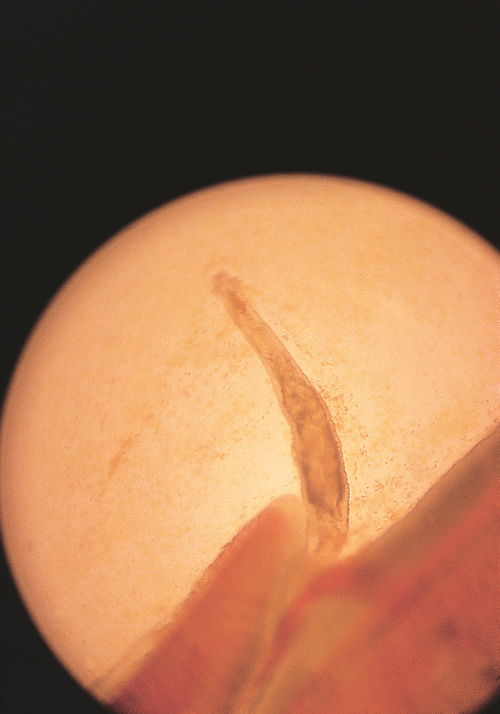Difference between revisions of "Ornamental Fish Q&A 25"
Ggaitskell (talk | contribs) |
|||
| Line 11: | Line 11: | ||
Careful examination of the parasite as it moves free of the gill tissue will reveal the presence of eye spots and the absence of paired hooks which are characteristic of ''Gyrodactylus''. | Careful examination of the parasite as it moves free of the gill tissue will reveal the presence of eye spots and the absence of paired hooks which are characteristic of ''Gyrodactylus''. | ||
| − | |l1= | + | |l1=Dactylogyrus |
|q2=With what clinical signs might it be associated? | |q2=With what clinical signs might it be associated? | ||
|a2= | |a2= | ||
| Line 17: | Line 17: | ||
Grossly, the gills appear swollen and have a grayish color, caused by the mucus covering the surface. The reduced oxygen uptake may cause an increased rate of opercular movements and fish may gather at the surface of the water, below waterfalls, or near air stones. | Grossly, the gills appear swollen and have a grayish color, caused by the mucus covering the surface. The reduced oxygen uptake may cause an increased rate of opercular movements and fish may gather at the surface of the water, below waterfalls, or near air stones. | ||
| − | |l2= | + | |l2=Dactylogyrus#Clinical Signs |
|q3=What treatments are commonly recommended for its control? | |q3=What treatments are commonly recommended for its control? | ||
|a3= | |a3= | ||
| Line 27: | Line 27: | ||
''Dactylogyrus'' is an oviparous species so cleaning and disinfection of tanks may be useful to eliminate the eggs. The eggs are resistant to chemical treatments so repeated treatments may be necessary to control the problem. | ''Dactylogyrus'' is an oviparous species so cleaning and disinfection of tanks may be useful to eliminate the eggs. The eggs are resistant to chemical treatments so repeated treatments may be necessary to control the problem. | ||
| − | |l3= | + | |l3=Dactylogyrus#Treatment |
</FlashCard> | </FlashCard> | ||
Revision as of 16:36, 30 October 2011
| Question | Answer | Article | |
| What organism can be identified in this photomicrograph? | The photomicrograph is of a gill squash preparation under low power. A single gill fluke (Dactylogyrus) is attached to the gill lamellae. Careful examination of the parasite as it moves free of the gill tissue will reveal the presence of eye spots and the absence of paired hooks which are characteristic of Gyrodactylus. |
Link to Article | |
| With what clinical signs might it be associated? | In moderate numbers these flukes can cause significant gill irritation resulting in excessive mucus production and gill hyperplasia. Grossly, the gills appear swollen and have a grayish color, caused by the mucus covering the surface. The reduced oxygen uptake may cause an increased rate of opercular movements and fish may gather at the surface of the water, below waterfalls, or near air stones. |
Link to Article | |
| What treatments are commonly recommended for its control? | A number of treatments are commonly recommended for controlling monogenean flukes. Formaldehyde added to the water is often used. Organophosphorus is also used, but may not be available for use in all countries. Marine species respond well to reversed salinity. Dactylogyrus is an oviparous species so cleaning and disinfection of tanks may be useful to eliminate the eggs. The eggs are resistant to chemical treatments so repeated treatments may be necessary to control the problem. |
Link to Article | |
